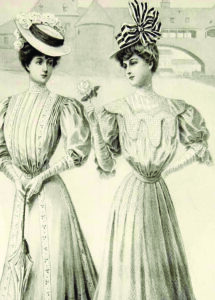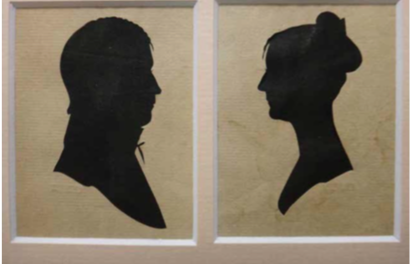(Editor’s note: DeeDee Wood is the owner of Black Cat Curiosities, an online antiques research and sales venue.)
As we consider our wardrobe for the spring and summer and begin bringing out clothes from the closet, you might want to consider your shirts and the history of something called a shirtwaist, a garment that enhanced and modified women’s clothing lines in the 1890s and beyond, spanning the late Victorian and Edwardian periods of fashion.
The term shirtwaist or “waist” refers to a garment worn in the upper portion of the body.
Often called a bodice to the 19th century woman (a bodice was the upper portion of a dress), a shirtwaist ended at the waist.
It had sleeves, and was fashioned akin to a man’s shirt, but with added flare and feminine touches, such as design work and sleeves, embellishments, and sometimes lace and fancy buttons. 
They were generally made from cotton or linen, and were a garment that changed with the changing needs of women during this time period, from the turn of the century forward.
During the time period when this fashion idea was conceived and executed, shirtwaists were worn by women entering the workforce.
A female worker’s fashion was modeled after a man’s attire, with the look of a turned down collar, sleeves and cuffs.
The shirt, which originally ended at the waist, allowed for less restriction in female clothing, and helped the movement needed to execute jobs, whether they be in an office or a factory, among other employment opportunities.
These working shirtwaists were simplistic, dignified, and designed for mobility.
Suffragettes, a term used for women who fought for the right to vote, adopted the look of the shirtwaist as well, due to more movement afforded to them while wearing this garment, unlike the bodices and structured, restricting garments of the past, such as boning and inner linings of traditional women’s upper body garments.
The “waist” represented a symbol of female progression, as they began to earn their own wages, fight for voting rights, and were presented opportunities to escape from household duties and chores that had become the standard.
The shirtwaist was manufactured in conjunction with fashion movements, such as the Aesthetic Dress movement, began in England in the 1850s. The idea was to move away from restrictive clothing like corsets and binders, whale bone ribbing and heavy layers, and move toward a garment like a shirtwaist.
They could be washed by hand, quickly, in a basin or early versions of modern sinks, and be hung out to dry, often affording convenience to a woman on the move.
The shirtwaist also cut a handsome figure in silhouette, mainly being accompanied by a long, floor length skirt, with the fashionable shirtwaist coming to just the top of the skirt, at the waist.
Many women still wore corsets under their shirtwaists during this fashion time period, due to the fact they enjoyed the “cut” it gave their figure. Magazine ads of this time period showed active women wearing a dizzying amount of variety in the garment, for all occasions.
In the early 1900s, at the turn of the century, the shirtwaist industry was a very competitive one.
Large cities, with the might and production brought on by the Industrial Revolution, teamed with manufacturing of all sorts of textiles, including the shirtwaist.
Philadelphia and New York City made the majority of shirtwaist garments in the United States at the time. Manhattan had more than 400 factories producing garments, employing more than 30,000 workers, many of them immigrants to this country.
The Triangle Shirtwaist Factory, located in Greenwich Village, had a tragic fire in 1911 that took 146 lives, making it one of the biggest factory disasters in U.S. history.
It also brought to light poor working conditions and lack of checks and balances in early manufacturing plants and production factories for garments and textiles.
The shirtwaist garment will forever be linked to this tragic event in manufacturing history.
As fashion usually dictates the progression and movement of a society, the female shirtwaist represents the movement of fashion in the direction of women in the workplace, the need for comfort over stylized ideas of garments and the mobility and realistic expectations of how a garment will interact with the wearer.
The term “shirtwaist” conjures up ideas of early factories and the dangers workers faced, the high production of the Industrial Revolution, and the convenience of a garment that helped women change in many ways in the early part of the 20th century and beyond.




